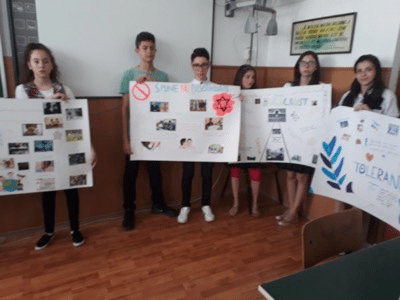This project, developed by Cerasela Marin in Campina, consisted of a series of activities that started with videos and discussions about the Holocaust, continued with learning about the local Jewish community and ended with lessons and actions about tolerance, discrimination and human rights.
Firstly, a project team was formed, consisting of 30 students, teachers and parents. In the first activity, titled “When reason is asleep. Never forget!” students watched documentaries about the Holocaust and discussed the causes and consequences of the Holocaust at personal and community level. They understood that intolerance can have strong negative effects.
The second activity consisted of a visit to the Campina Synagogue and its museum, as well as the Jewish cemetery. Students learned about the Jewish community of Campina and about its contribution to the development of the city, but also about the suffering they endured during the Holocaust. Today there are only two Jews living here, while in 1940 there were 300.
The following activity engaged students in an experiential learning process focused on tolerance, communication and conflict resolution. Through activities such as simulations, role-plays and social dilemmas students experienced what it feels like to be ‘the other.’ Following this activity, students gathered school supplies, clothes and toys to make a donation to the children in Saint Filofteia orphanage.
An activity called Human rights for all engaged students in a contest with questions about the Holocaust, human rights and equal opportunities. Students also had to create a collage/poster/drawing on the same topics.
Three activities were carried on at the end of the project. One focused on developing an exhibition with the products of the project, with photographs through which students expressed their thoughts, feelings and ideas on the subjects discussed throughout the project. Another activity was a roundtable on the topic of discrimination in contemporary society and various ways of countering it. Finally, a portfolio of the project in electronic format was developed by the students and published in a special edition of our school online magazine.
Student reflection: This project helped me learn new things, collaborate with colleagues I never worked before and get to know them better. I liked all the activities, but most of all I was impressed by the visit to the synagogue where I learned about people who lived among us, but who suffered unimaginable tragedies. I don’t want anything like that to happen again.
Given the positive feedback from students, parents and other teachers involved in the project, the plan is to further develop the project next year and involve more students and teachers and to start the project earlier, in order to have more time for the activities.
